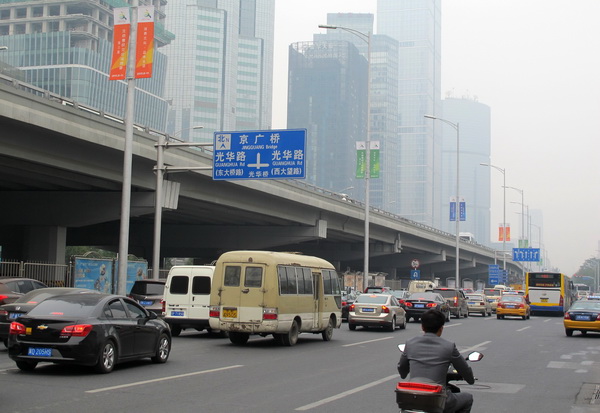

Beijing will soon solicit public opinion on a new vehicle emission standard, which is expected to be implemented in 2017 as the toughest ever in the city since it took air pollution control measures in 1998.
Li Kunsheng, head of the Beijing Municipal Environmental Protection Bureau's vehicle emission administrative office, released the news on Nov 9 at a preliminary assessment meeting of the Report on Beijing Air Pollution Control Process: 1998-2013, conducted by the United Nations Environment Program (UNEP) and the Beijing Municipal Environmental Protection Bureau.
Beijing has been working on the new vehicle emission standard, which is in its sixth stage, in response to the New Air Pollution Control Law which stipulates that key regions can implement stricter pollution emission control measures, said Li.
The new standard covers five categories: motor gasoline, automotive diesel fuel, light gasoline motor cars, heavy finished automobiles, and heavy-duty engines.
Representatives from UNEP Asia-Pacific introduced results of their assessment of Beijing's work on air pollution control measures from 1998 to 2013. The results showed that the concentration of carbon monoxide, sulfur dioxide, nitrogen dioxide, and PM 10 has declined thanks to the measures to control coal and vehicle emissions despite the sharp increases in population, the number of motor vehicles and energy consumption.
Beijing's current regional vehicle emission standard is similar to that of Europe, and automobile companies need a period of time to prepare for the new stricter one which hopefully can be carried out in 2017.
Eight categories of new heavy vehicles, including public transportation vehicles, environmental sanitation, and postal vehicles, will be equipped with particle emission controls next year, reducing emissions by 90 percent.
He Kebin, a professor of environmental science at Tsinghua University, said Beijing has sped up its efforts in air pollution control compared with the past 15 years and is working to reduce the annual average PM 2.5 concentration to less than 70 microgram per square meter this year.
The days of serious air pollution are decreasing, said He, but it will take time to improve further. In order to reach the emission goal, within the next 10 years Beijing needs to solve the problem of coarse coal particles combustion and increase efforts in cooperative prevention.
"A mechanism is now available to guarantee the city's blue sky, but it is only used for major events. A long-term plan for air pollution control is needed," He added.
 |
|
The traffic flow on the East Third Ring Road covered in haze in Beijing on Sept 22, 2015. [Photo by Bao Xinguo/Asianewsphoto] |